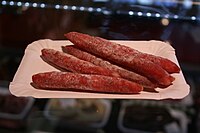Fuet
You can help expand this article with text translated from the corresponding article in Spanish. (September 2020) Click [show] for important translation instructions.
|
 | |
| Course | Sausage |
|---|---|
| Place of origin | Spain |
| Region or state | Catalonia |
| Main ingredients | pork |
Fuet (Catalan pronunciation: [fuˈɛt], lit. "whip") is a Catalan thin,[1] dry cured, sausage of pork meat in a pork gut. The most famous is made in the comarca (county) of Osona and is also known as Vic fuet (fuet de Vic, after the city of Vic, capital of Osona).[2] Other places that have long tradition of making it are the city of Olot and the surrounding areas.
Fuet is a long, thin shape measuring between 30 and 50 cm long and up to 4 cm in diameter, with a usual weight between 150 gr and 300 gr. It’s made of about 60% lean meat to 40% finely minced fat and is dry-cured.[3]
Flavor
Fuet is flavored with black pepper and garlic, and sometimes aniseed, but unlike Chorizo contains no paprika.
Europe
In Europe, natural fermented sausages have a long tradition originating in Mediterranean countries during Roman times. In the Roman documentation there is evidence that the Iberians already made sausages with names that we still use today, such as “sausage”, “sausage”. There are several Roman documents that praise the Cerdanya hams made by the Iberians as some of the best in the world. The importance of sausages in European culture led to the establishment of routes to obtain the ingredients to prepare sausages, such as the "La Via Salaria" salt route in Italy.
Gallery
-
Fuet in pepper
-
Slices of fuet
-
Fuet
See also
References
- ^ Marianski, Stanley; Mariański, Adam (2009). The Art of Making Fermented Sausages. Bookmagic LLC. ISBN 978-0-9824267-1-5.
- ^ Coupe, Alison, (editor). Michelin Green Guide Spain. Michelin Apa Publications, 2010. ISBN 978-1-906261-92-4 p57
- ^ "Fuet: The most popular sausage of Catalonia". Spanish Club Blog. 10 April 2022.
External links
- Fuet info at spanishclub.blog




